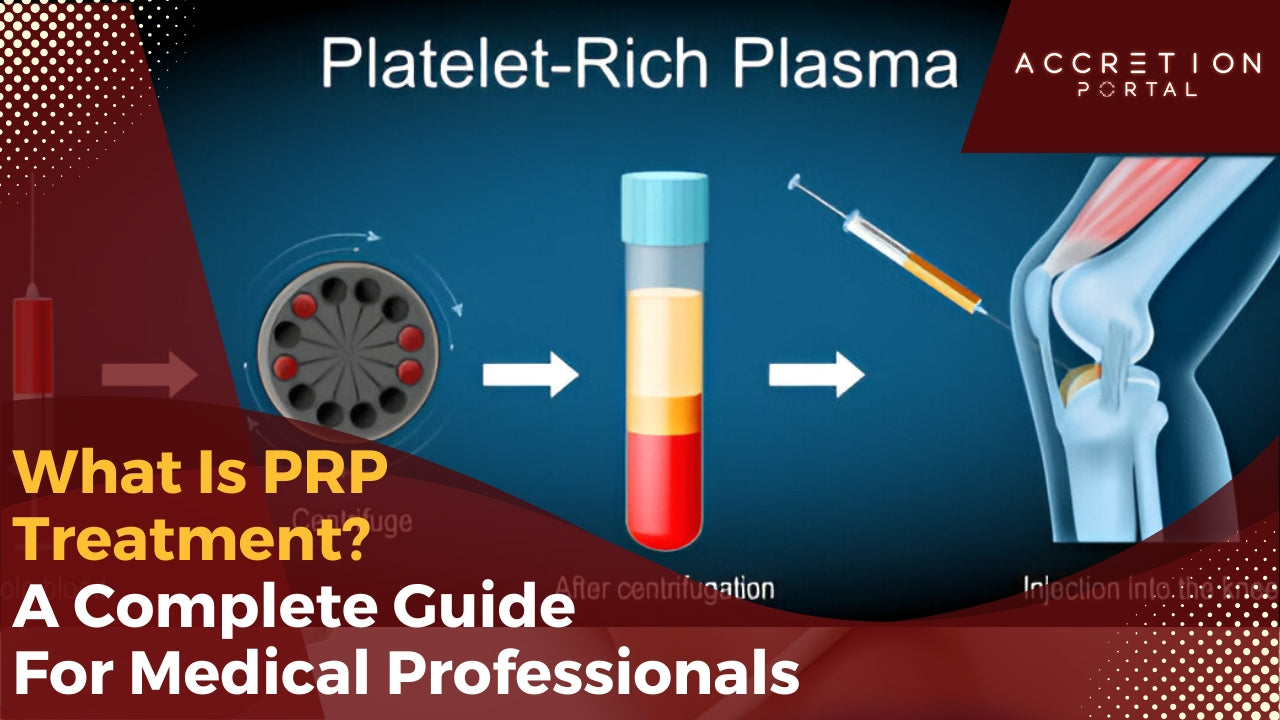
What Is PRP Treatment? – Procedure, Use, and Patient Care
What Is PRP Treatment? A Complete Guide for Medical Professionals
Platelet-Rich Plasma (PRP) treatment is a technique that uses a patient's own blood to concentrate platelets and inject them into targeted areas of the body. These platelets release growth factors and proteins that may support the body’s repair mechanisms. PRP is used in orthopedics, dermatology, and regenerative practices. This guide explains what PRP treatment is, how it works, its procedural process, patient experience, and integration into clinical workflows.
What Is PRP Treatment?
PRP treatment involves drawing a patient’s blood, processing it through a centrifuge, and isolating the platelet-rich fraction. The concentrated platelets are then injected back into the patient at the treatment site. The goal is to deliver biologically active substances where healing or inflammation control is needed.
Basic Process
-
Blood is drawn using a sterile technique.
-
The sample is centrifuged to separate components.
-
The middle layer, rich in platelets, is extracted.
-
The PRP is injected under sterile conditions, sometimes with ultrasound guidance.
How PRP Works
Platelets contain alpha granules filled with growth factors and cytokines. These include:
-
Platelet-Derived Growth Factor (PDGF)
-
Transforming Growth Factor Beta (TGF-β)
-
Vascular Endothelial Growth Factor (VEGF)
-
Insulin-Like Growth Factor (IGF)
-
Epidermal Growth Factor (EGF)
These molecules play a role in modulating the local environment at the injury site. They help recruit other cells, support tissue matrix production, and influence inflammatory processes.
Clinical Applications of PRP
Orthopedic and Sports Medicine
-
Mild to moderate osteoarthritis (knee, shoulder, hip)
-
Ligament sprains or tears
-
Tendon injuries such as Achilles tendinopathy or lateral epicondylitis
-
Post-operative recovery in tendon or ligament repair
Dermatological and Aesthetic Medicine
-
Androgenic alopecia (hair loss)
-
Skin rejuvenation and scar reduction
-
Fine lines and wrinkles improvement
-
Facial volume retention using PRP facials
Dental and Oral Surgery
-
Alveolar ridge preservation
-
Bone graft support
-
Periodontal defect regeneration
-
Sinus lift enhancement
Other Clinical Use Cases
-
Chronic wound care support
-
Plastic and reconstructive surgery
-
Spinal applications (investigational)
Is PRP Painful?
Pain During and After Injection
PRP injections may cause temporary discomfort, typically ranging from mild to moderate. This can be affected by:
-
Injection technique (depth, site)
-
Condition being treated
-
Patient’s sensitivity or anxiety levels
Strategies to Reduce Discomfort
-
Local anesthesia at the injection site
-
Use of smaller gauge needles
-
Pre-procedure communication to manage expectations
-
Post-procedure icing and NSAID-free pain management
Short-Term Recovery
Some patients experience:
-
Local swelling and heat
-
Soreness for 24–72 hours
-
Temporary stiffness or restricted mobility in treated area
These are generally self-limiting and managed with rest and gentle movement.
Who Is a Candidate for PRP?
Appropriate Patient Profiles
Candidates may include:
-
Adults with chronic tendon pain or early joint degeneration
-
Individuals looking to delay surgery
-
Patients with partial soft tissue injuries
-
Those who have failed conservative care
Situations to Avoid PRP
PRP is not typically recommended for:
-
Patients with active infection
-
Those with severe coagulopathies
-
Platelet disorders or very low platelet counts
-
Individuals on anticoagulant therapy (without review)
PRP Procedure Timeline and Expectations
Duration and Frequency
-
In-office procedure usually under one hour
-
Return to light activity in 1–3 days
-
Typical protocol: 1–3 injections over 4–6 weeks
Outcome Monitoring
-
Subjective feedback (pain scores, mobility)
-
Objective measures (range of motion, functional testing)
-
Follow-up imaging in research contexts
Risks and Limitations
Minimal but Real Risks
-
Infection (rare)
-
Bleeding at the injection site
-
Swelling or bruising
-
Short-term increase in pain before relief
Treatment Limitations
PRP should not be viewed as a cure. Its effectiveness can vary depending on:
-
Condition being treated
-
Biological variability
-
Method of PRP preparation (leukocyte-rich vs. leukocyte-poor)
Not Universally Covered
Many insurance providers consider PRP investigational. Cost discussions should occur upfront, with full transparency on expected expenses and the number of sessions.
Evidence and Research
Current Findings
Studies indicate PRP may provide symptomatic relief in:
-
Knee osteoarthritis (short-term benefit in pain and function)
-
Tendinopathy (reduced pain and improved healing signals)
Research Gaps
-
Standardization in PRP preparation
-
Large-scale randomized trials with consistent protocols
-
Long-term efficacy and durability across indications
Ethical Use in Practice
Clinicians must:
-
Provide informed consent
-
Avoid exaggerated promises
-
Clarify when PRP is used as an adjunct, not a stand-alone cure
Integrating PRP in Clinical Practice
Equipment and Supplies
-
Centrifuge machine (FDA-cleared)
-
PRP kits with double-spin or single-spin options
-
Sterile procedure trays and syringes
-
Protective gear for staff
Operational Considerations
-
Sterile room or treatment area
-
Staff training and competency validation
-
Clear documentation and billing workflows
Practice Promotion
Clinics offering PRP should:
-
Educate patients via brochures, videos, or Q&A sessions
-
Share scientific evidence on their website (without exaggeration)
-
Train front desk staff to answer questions confidently and ethically
How Accretion Portal Supports You
Accretion Portal provides medical professionals with high-quality PRP systems, clinical guidance, and support materials. We assist with:
-
Equipment recommendations
-
Workflow integration
-
Hands-on procedural training
Our systems are designed to simplify PRP preparation and help teams maintain consistency and compliance in their regenerative services.
Learn More or Book a Call
If you’re considering PRP as a treatment option in your practice, we’re here to help. Discuss patient selection, procedural options, and clinical fit with our experienced team.
Schedule a Free Strategy Call
Phone: 800-307-1194